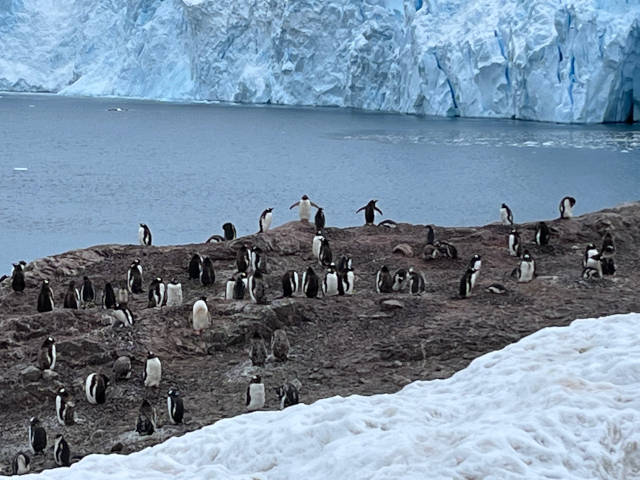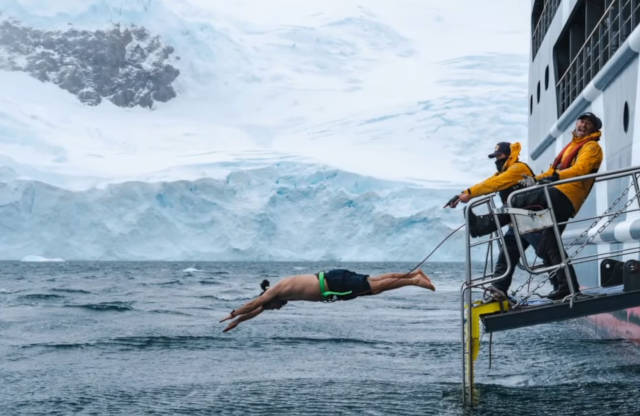I can’t believe it is actually happening. We are at the airport in Punta Arenas, Chile (pronounced Chilay, and not Chilli, the locals will tell you), one of the southernmost cities in the world, all dressed in a hundred layers and waiting to board the plane that will fly us across the (in)famous Drake’s Passage and land us on King George Island. Gateway to Antarctica! We are a group of about 65 friends and acquaintances from all over India, on this adventure half-way across the world, titled, predictably, Adventure Antarctica.
This destination was on Ramesh’s bucket list for a long time. (Maybe 10 years?) When we first spoke about it, it seemed like the perfect trip for a pair of empty nesters. But in the intervening years, I have been plagued by doubt. Why was I, the conscious consumer and aspiring environmentalist, even thinking of going on this trip? To see a fragile ecosystem that was so visibly being affected by global warming? I had no answers, only a spouse whose enthusiasm for the trip was unflagging and infectious, so here we are.

[Off to Antarctica!]
As the BAe 146 aircraft touches down on King George Island, 120 km off the coast of Antarctica, I look out the window eagerly, and see... no ice! None at all. Not a single plant or tree either. I remind myself to hold my mental horses, as we deplane at Frei Station. The island is tiny, covered in black soil, a couple of makeshift buildings (including a church!) and a pebbly beach covered in bright red algae. But there they are — PENGUINS! Hundreds of them, waddling around without a care in the world. We are in the right part of the world, after all!

[Land of the penguins]
We get on to Zodiac boats that take us to the vessel that will be our home for the next five days. The Magellan Explorer is a superbly appointed vessel. Lots of dos and don’ts are handed out, there’s a mandatory evacuation drill on the boat, and she pulls anchor and sets off. We meet Captain Torry Sakkariasen, Master of the ship, Hadleigh Measham, the expedition leader and his team that evening, as they help us understand the unique topography and characteristics of Antarctica. They also reinforce the rules around visiting the islands — no food to be taken off the boat or onto the islands; no leaving anything behind (tissues, wipes, plastic); and we must follow a unique Antarctic ritual: we must clean our pants and boots with a water spray to ensure no organic matter is stuck to them, and step into a disinfectant before leaving and returning to the ship.
We saunter onto the deck as night falls on the beautiful Antarctic waters.
Nothing, absolutely nothing, could have prepared me for the first morning glimpse of Antarctica. Majestic. Spectacular. Jaw-dropping. Superlatives don’t cut it. White as far as the eye can see. Mountains covered in ice, massive ice shelves, some of them a hundred feet high, icebergs that stand in the middle of the ocean, in amazing shapes, and a breathtaking shade of blue (the ice is so tightly compacted that when light falls on it, it absorbs all colours except blue, so all icebergs and ice shelves look blue to the human eye). Straight out of Nat Geo. I have goosebumps as I look at this magnificent display of Nature, humbled by the realisation that some of this ice has been here for millions of years.

[The blue, blue ice]
The ship drops anchor, and we get ready to head out on our first excursion. The drill is laborious at first — multiple layers to cover the head and ears, ski goggles to protect against the UV, thermals under the parka, the boots that must be covered by the ski pants (why did I not pick the pants with the zip at Decathlon??)

[Zodiac and the ship that’s home]
At the first stop on Palaver Point, we spot thousands and thousands of Gentoo penguins. (If you don’t see them, you will surely smell them!) Our guides point out to us the penguin highways that are used by the birds to go down to the water. They ask us to stay away from them. If we walked on those tracks with our boots, they would become too deep for the birds to use (I would never have thought of that!)
[A penguin highway]
We start to trek up to the top of the hill, and soon realise that it is much tougher than it looks. The ice is slippery, the buff gets in my way of breathing, and I have to stop every now and then and take my gloves off to take pictures. Well, I don’t have to, but what’s a trip to Antarctica without a penguin selfie?
The view from the top is spectacular and well worth the effort. There are lakes nestled inside the hills, surrounded by thick walls of ice. A Wedell seal is lazing on the snow, a Skua flies overhead, its shrill call breaking the silence. We watch respectfully and in awe, aware that we are intruders in this wonderful vast space that these creatures have called home for aeons. It is a great reminder of mankind’s insignificance, in both the geographical and historical sense. (I mean, the earth is vast and is billions of years old, and here we are, trying to make change happen. We have only managed to mess things up.)

[Hello, how do you do?]
The afternoon trip is to Portal Point, on the continental landmass of Antarctica. Here we see chinstrap penguins, so called for the unique facial feature that sets them apart. Someone cheekily says it looks like the penguins are wearing face masks, but one hopes the Coronavirus never reaches Continent 7.
In the evening, back on the ship, Hadleigh and his team seek to educate us some more. Did I mention the team? There is a cetologist (whale specialist), a glaciologist, a polar bird expert, a master diver, several naturalists, an ice climber and a marine biologist, among them. And we soon realise how each of them enriches our experience.
Agus, the bird expert, tells us about the three kinds of penguins that inhabit the Antarctic peninsula and the islands — gentoo, chinstrap and Adelie. The Emperor Penguins, made famous on film, are found much farther south. Penguins cannot fly in the air but can fly underwater, often at remarkable speeds. We learn about the other birds in the region — albatross (I didn’t see one), southern giant petrels (they really are very large birds), the skua, gulls, terns and cormorants.
Someone asks about the Doomsday Glacier, so we are promised a session on glaciers for the following day.
The next morning, we are all up on the deck at 7 am, watching with awe and disbelief as the captain manoeuvres the vessel through the Lemaire Channel — a narrow strait hemmed in by huge ice cliffs on both sides. We are lucky it is a nice day, and there are not too many icebergs blocking the channel. Even as we watch, a giant piece of ice breaks off from one of the cliffs and crashes into the sea with a noise like thunder, and the resulting wave rocks our ship a little bit (this is called calving).

Today is our chance to see Adelie penguins and go hiking with snowshoes on Petermann Island. At the afternoon stop - Port Charcot- we get to see first-hand how quickly the Antarctic weather can change. When we started the climb, it was clear and still, but within half an hour, the wind picks up significantly, and it begins to snow heavily. (That was another revelation to us, that the amount of snowfall had gone up in recent years due to global warming. Usually, Antarctica receives very little rainfall.)
That evening, it is Federico who talks to us about ice, and its many glorious forms. I learn the difference between glaciers, ice shelves and icebergs. (take this quiz). In layman’s terms, glaciers are formed on land; an ice shelf is a large area of ice that extends from a glacier into the sea; and an iceberg is a massive piece of freshwater ice, just floating around in the sea. Looking beautiful. And sometimes causing accidents. (By the way, the T word is NOT to be mentioned anywhere on board the ship. Honour code.)

[Iceberg or Icebird?]
Federico has put together a presentation on Doomsday Glacier, the nickname for Thwaite’s Glacier. It is monitored closely for its potential to cause a rise in sea levels worldwide, and some of the direst predictions say the Thwaite’s Ice Shelf, extending from this glacier, may break off in a decade from now, and cause several coastal cities to experience a significant rise in sea levels. If that happens, we will definitely experience it in Chennai. Something to think about.
The next morning we wake up to Hadleigh’s announcement that a couple of whales have been spotted around the ship, and everybody is up on the deck in no time. And there they are. A pair of Minke whales, circling the ship, breaching the surface every now and then, playing with the Zodiacs as they head out to shore. Kristy, the marine biologist, tells us it is a mother and calf pair, and it must be the young one that is curious about us, so the mother hangs around as well making sure s/he is safe. They did look like they were doing rolls in the water and having a good time.
[Whales having fun]
Our excursion today is to Neko Harbour, a quiet and beautiful harbour on the continent. More penguins, a lovely sighting of Antarctic fur seals close to the shore, another trek up a fairly steep hill. Once again, on our way down, we are caught by surprise by the sharp rise in winds. Janice, who is an ice climber by training and passion, shows us how to kneel into the wind and let the gust pass, instead of trying to walk into it and risk being blown off (potentially into a hidden crevasse!)
The afternoon is crazy! The Polar Plunge! Jumping into freezing waters is many people’s idea of an adventure. Some say it is a way to push yourself out of your comfort zone; some say it is the way to break free from fear. I am not sure what it means to me. I did think about taking the plunge, I even carried my swimming costume, but in the end, I chicken out. No Polar Plunge for me. About half the people in our group do it, the other half is sensible like me :-)

[The Polar Plunge]
That evening we go off the ship but there is no landing planned, instead we go for a nice ride in the Zodiacs into Wilhelmina Bay, which is known for whale spotting. There are some kayakers out on the water, and the rest of us in Zodiacs, when suddenly we see whales all around us. Nozomi, the naturalist accompanying us, tells us these are humpback whales, gentle giants that feed in polar waters and migrate up to 15,000 km towards tropical waters. Each humpback whale has a unique tail pattern; it’s like its signature. Whale watchers and conservation enthusiasts can upload pictures of whales (or just whale tails) spotted by them to www.happywhale.com and the site IDs the whale and tracks it.

[The humpback whale. Every tail is unique]
[Video: Humpback whales]
In one of the evening sessions we had learnt of the exploits of Jean-Baptiste Charcot, leader of the first French expedition to Antarctica in 1904. Using the ship’s desktop, I read up on some of the other Antarctic explorers — Amundsen, Scott, Shackleton. Fascinating how they navigated Drake’s Passage and reached this remote corner of the world, with little more than grit and determination. I ask Hadleigh how long he has been coming here, and does he see any change over that time? Hadleigh says he’s been coming for over ten years. Yes, there is a spot that he photographs every year, and yes, he thinks the ice is receding.
The next morning the ship navigates another narrow channel to enter Deception Point, a volcanic crater. The landscape around us is starkly different — similar to the first day at King George’s Island. That tells us that we are coming away from the Antarctic peninsula, back towards the South Shetland islands. A trek to the top of the crater rewards us with great views.

[Volcanic crater at Deception Point]
At around 4 pm Hadleigh tells us we must be confined to the ship because it is way too windy for the Zodiacs to take us out. And how does he know it is windy? Because he saw a bird flying... backwards!
The next morning, we are scheduled to dock at Frei Station and fly back to Punta Arenas. A few anxious hours, when we are told the airplane is not cleared to fly due to bad weather. If we can’t fly back, we may have to sail across Drake’s Passage, and no one wants that. Drake’s is a stretch of sea between South America and the Antarctic peninsula, with no landmass at that latitude around the world; it is known for rough winds and giant swells. It is NOT for the weak at heart, and certainly not for first time ocean-farers. Eventually that evening we are cleared to fly. We say our goodbyes to the fabulous crew on board and head back to life as we know it.

[Every trip is better with friends]
A big shout out to our fellow travellers on this trip — each one of you helped make this journey as memorable as the destination. I have borrowed liberally from the photos and videos shared by you on the WhatsApp group. The professional photographs I have shared are thanks to Suresh Chitturi, Anais Afrika and Adi Rajshirke. A special thanks to the First Couple of the trip (you know who you are) and the organisers for the extraordinary planning, attention to detail and flawless execution.
This trip has been like no other. Never before, never again. And I begin to appreciate what I saw in a brochure on my first day — KNOW FIRST, THEN PROTECT. Most visitors to Antarctica are so moved by its majesty and beauty that they become ambassadors for its preservation. We will be no exception. My husband Ramesh and I are deeply grateful for the opportunity to visit this beautiful part of our planet, and even more acutely aware of our responsibilities as citizens of the world.

[Jai ho! Antarctica on the bucket list—check!]
Everyone has to be a conscious consumer now. We have no choice. Reduce/Reuse/Recycle. Say NO to single use plastic. Plant more trees. Save water. Take public transport where possible — so that, some day, our grandchildren and their grandchildren may also have the opportunity to visit a pristine Antarctica.
[Can't navigate the deck? View it in the browser.]
Still curious?
Must watch: BBC One: Frozen Planet, To the Ends of the Earth
Must read: IAATO guidelines

